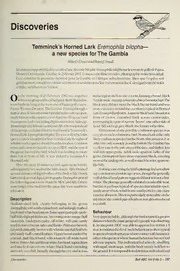
'Temminck''s Horned Lark Eremophila bilopha - a new species for The Gambia' PDF
Preview 'Temminck''s Horned Lark Eremophila bilopha - a new species for The Gambia'
Discoveries Temminck’s Horned Lark Eremophila bilopha— a new species for The Gambia MikeD.CreiivandBria?ij.Small LesauteursrapportentladecouverteduneAlouettebilopheEremophilabilophasurleterraindegolfedeFajara, DivisionOcddentale,Gambie,le23fevrier2002.L’oiseauaetefilmeenvideo,photographieetdecritendetail. Ceciconstituela premiere mentionpourlaGambieetl'Afriquesubsaharienne. Bienque l’especesoit generalementconsidereecominesedentaireetsettlementenclineaunerratismelocal,desegaresontetenotes aMalte,auLibanetauYemen. O nthemorningof23February2002we,together malarregionandforeear-coverts,formingabroad,black withatourgroupandlocalbirdguideBarryMamadou, ‘banditmask’,miningdownintoabroadmoustachial.The werebirdwatchingatthewestendofFajaragolfcourse, blackareadidnotmeettheblackbreast-bandandwas Fajara,WesternDivision,TheGambia.Passingthrougha moreextensivearoundtheeyethanistypicalinHorned narrowareaofNeocaryamacrophy'//c/bushesontoanopen, LarkEremophilaalpestns.Ananowblackband,broadestat sandyfairwaywithasparsecoverofgrasses(Poaceae)and front of crown, extended back across crown-sides, depauperateherbs(includingHyptissilaieolens,Siciaspp, terminatinginapairofnarrow‘horns’,oneeithersideof JpomoeasppmdNelsoniacanescens),BJS,wbowasjustahead head.Billandlegsgrey-black,thefonnerratherfine. ofthegroup,exclaimedthathehadfoundaTemminck’s Eliminationofanypossibleconfusionspecieswas FlomedLarkEremophilabilopha.Theeasewithwhichthis easygivensuchadistinctivebird.HornedLarkistheonly speciescanbeidentifiedatFirstoverruledanythoughtsof likelyconfusionspeciesbuttheNorthAfricantaxonE.a. whethersuchaspeciesshouldbeatthislocation.Common atlas(dieonlyremotelypossiblefonninTheGambia)has senseandcautioncausedarecapasMDCandtherestof ayellowtonetothepaleareasoftheface,anddarker,less thegrouplocatedthebird,whichwasfeedingnomore uniformupperparts. Adultmalesparrow-larks ofthe than 3m in frontofBJS. ItwasindeedaTemminck’s genusEremopterixhavemoreextensiveblack,covering HomedLark! mostoftheunderparts,aswellasmuchheavier,sparrow- Overthenext30minutes(andagainmorebriefly likebills. subsequently)westudiedthebirdclosely.BJSobtained Nothingconcerningthebird’splumageledustodraw severalminutesofdigitalvideoofthebird,whileDerek anyconclusionsaboutitsageorsex,thoughthegenerally Lamertookseveraldigitalphotographs.Duringthisperiod well-definedheadpatternsuggestedthatitwasnotafirst- thefollowingnotesweremadebyMDCandBJS.Others winter.Theplumagegenerallyexhibitedconsiderablewear, searchingforthebirdlaterthesamedaywereunableto butthisisperhapstypicalofspeciesthatinhabitopen, relocated. sandyareaswherewind-bornesandparticlescancause extremeabrasion.Thiswasparticularlynoticeableonthe Description tailwherethecentralpairoffeatherswasalmostreduced Medium-sized lark, clearly belonging to the genus toashaft. Eremophilawitharatherplainbodyandstrikinglymarked , black-and-whiteheadpattern.Entireupperpartspalesandy- Behaviour buffwithslightpinkishtone,becomingmoreorange-buff Veryapproachable,althoughthebirdretainedagreater ontertials.Underpartspaler,off-white,withpalesandy distancewhentheentiregroupof14peoplewasobserving washtolowerbreast-sidesandflanks.Primariesbrown; it.Atonepoint,MDCwasabletoapproachtowithin1.5 tailpredominantlybrownwithwhitishoutertailfeathers masitcontinuedtofeed.Suchbehaviourisoftentypical andsandy-buffcentralfeathers.Upperbreastmarkedby inspeciesfromdesertareaswherecontactwithhumansis abroad,darkblackband,withanarrowoff-whiteband eitherinfrequentorwherehumanbehaviourhasnothad below.Entirechinandthroatwhite;forehead,supercilium adverseimpacts.Thisindividualfedactively,shuffling andmuchofear-covertswhite;blackbandextending withrapid,shortsteps,withthebodymostlyheldlowto narrowlyoverbill,broadlythroughtheeyeandacross theground.Itwasimpossibletodetermineindividualfood Discoveries BullABC Vol9No2-137 4 ’ itemsbutbothinsectandplantfoodappearedtobetaken. References Thebirdwasfaithful to averysandyarea ofsloping 1. Borrow, N. and Demey, R. 2001. BirdsofWestern ground,althoughapedestrianrouteacrossthegolfcourse Africa. London, UK: A. & C. Black. wascloseby. 2. Cramp,S.(ed)1988.TheBirdsoftheWesternPalearctic.Vo! 5.Oxford:OxfordUniversityPress. Status and distribution 3. Keith,S.,Urban,E.K.andFry,C.H.(eds)1990.TheBirds Temminck’sHomedLarkisgenerallyconsideredaresident, ofAfrica.Vol4.London,UK:AcademicPress. pronetooccasionaldispersal.Accidentalshavebeen 4. Taylor,M.J.1992.FirstrecordofTemminck'sHorned reportedoutsideofthespecies’usualrange,between LarkEremophilatrilophainYemen.Sandgrousela:109 north-westMauritaniaacrossNorthAfricatonorthand LimosaHolidays,SuffieldHouse,Northnpps.NorfolkNR279BA. eastArabia,Syria,andeastandsouth-westIraq1-3,inMalta, UK. Lebanon2andYemen4 Thisappearstoconstitutenotonly . thefirstrecordforTheGambia,butalsoforanywherein AfricasouthoftheSahara. Second confirmed record of Forbes’s Plover Charadrius forbesi for The Gambia GordonKirk1andCliveR.Barbu* Enfevrier2002unPluvierdeForbesCharadriusforbesiaeteobservesurlacotegambienne.Cecineconstitueque ladeuxiemementionconfirmeepourlepays.L’examendespecimensauRoyaumeUnisembleindiquerqu'il s’agissaitd’unadulteenplumageintemuptial. F'orbes’s Plover Charadrius forbesi occurs in palefringes,whicharejustvisibleinFig1,suggestingthat savannasofwesternCentralAfrica2,breedinginrocky itmaynothavebeenafulladult.AfterclOminutesthebird upland areas ofNigeria in March-August3 andJuly- flew off, uttering a double call as it departed. On 10 AugustinGhana5.Itisknowntomoveshortdistances February2002at08.00hrsCBandPaulMannersvisited fromitsbreedinggroundsandtoundertakelongerjourneys, thesamesiteandfoundthebirdstillpresent.Itmoved althoughtheroutesinvolvedarenotunderstood2 The betweentwoareas,themuddypoolandadrierpartsome . onlyconfirmedrecordfromThe Gambiaisofone at 250 maway.PMtookaseriesofphotographsandCB Bansang(13°26’N14°39’W)inCentralRiverDivision,on obtainedashortsoundrecordingoftheflightcall. 23November19791 -Thereisalsoanunconfirmedjanuary On returning to the UK, GK visited the Natural recordfromcoastalWesternDivision, andrecordsin HistoryMuseum(Tring)toexamineskinsofForbes’s southandeastSenegalinFebruary16 Plover(35specimens).About50%hadbeencollectedin . On6February2002,GKandasmallgroupofBritish Nigeria,withmostotherrecordsfromotherWestAfrican birdersspentadaywithCBinWesternDivisionofThe countries(SierraLeone, Liberia, ‘GoldCoast’, ‘British Gambia.Duringmid-afternoonsomeofthegroupspent Cameroon’andCoted’Ivoire),andtwotakenin‘north timewatchingPalearcticshorebirdsonamuddypool Rhodesia’and‘westTanganyika’(countrynameswithin behindthebeachatTujering(13°19’N16°47’W)insouth quotesappearasontherelevantspecimenlabels).The GambiaontheAtlanticcoast.Theseasonalpoolwas birdshadbeencollectedinmostmonths,withthemajority borderedbyvegetationdominatedbyTamariskpentandra ofthebreederstakeninMay.Manyofthenon-breeding andwhilesearchingthroughnumbersofBlack-winged adults,labelledashavingbeencaughtinDecember- StiltHimantopushimantopus,CommonGreenshankTringa February hadsomepalefeatherfringes,especiallyonthe , nebularia,WoodSandpiperT.glareolaandYellowWagtail secondariesandinnerprimaries,likethoseontheGambian Motacillaflava, GKsawasmallwaderalightandCB bird.TheGambianbirdalsohadthefollowingfeatures immediatelyidentifieditasaForbes’sPlover. CBhas thatappeartoeliminatethepossibilityofitbeingajuvenile recentexperienceofthespeciesfromGuinea-Bissauand (see Fig 1): no palefringestothe mantle orscapular GuineaConakry,bothinOctober, instonier, lateritic feathers,ablack(notbrown)breast-bandandgrey(not grasslandsathigheraltitudes.Weobtainedprolonged, buff)faceandthroat.GKconcludedthattheobserved closeviewsofthebirdingoodlight.Themainquestion birdwasanadultinnon-breedingplumage.Thesexesare wasthebird’sage.Afewwingfeathersappearedtohave similar7 . 138-BullABC Vol9No2 Discoveries
